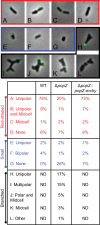Absence of the Polar Organizing Protein PopZ Results in Reduced and Asymmetric Cell Division in Agrobacterium tumefaciens
- PMID: 28630123
- PMCID: PMC5553032
- DOI: 10.1128/JB.00101-17
Absence of the Polar Organizing Protein PopZ Results in Reduced and Asymmetric Cell Division in Agrobacterium tumefaciens
Abstract
Agrobacterium tumefaciens is a rod-shaped bacterium that grows by polar insertion of new peptidoglycan during cell elongation. As the cell cycle progresses, peptidoglycan synthesis at the pole ceases prior to insertion of new peptidoglycan at midcell to enable cell division. The A. tumefaciens homolog of the Caulobacter crescentus polar organelle development protein PopZ has been identified as a growth pole marker and a candidate polar growth-promoting factor. Here, we characterize the function of PopZ in cell growth and division of A. tumefaciens Consistent with previous observations, we observe that PopZ localizes specifically to the growth pole in wild-type cells. Despite the striking localization pattern of PopZ, we find the absence of the protein does not impair polar elongation or cause major changes in the peptidoglycan composition. Instead, we observe an atypical cell length distribution, including minicells, elongated cells, and cells with ectopic poles. Most minicells lack DNA, suggesting a defect in chromosome segregation. Furthermore, the canonical cell division proteins FtsZ and FtsA are misplaced, leading to asymmetric sites of cell constriction. Together, these data suggest that PopZ plays an important role in the regulation of chromosome segregation and cell division.IMPORTANCEA. tumefaciens is a bacterial plant pathogen and a natural genetic engineer. However, very little is known about the spatial and temporal regulation of cell wall biogenesis that leads to polar growth in this bacterium. Understanding the molecular basis of A. tumefaciens growth may allow for the development of innovations to prevent disease or to promote growth during biotechnology applications. Finally, since many closely related plant and animal pathogens exhibit polar growth, discoveries in A. tumefaciens may be broadly applicable for devising antimicrobial strategies.
Keywords: Agrobacterium; PopZ; cell division; cell polarity; chromosome segregation; growth polarity.
Copyright © 2017 American Society for Microbiology.
Figures








Similar articles
-
Loss of PopZ At activity in Agrobacterium tumefaciens by Deletion or Depletion Leads to Multiple Growth Poles, Minicells, and Growth Defects.mBio. 2017 Nov 14;8(6):e01881-17. doi: 10.1128/mBio.01881-17. mBio. 2017. PMID: 29138309 Free PMC article.
-
Loss of PodJ in Agrobacterium tumefaciens Leads to Ectopic Polar Growth, Branching, and Reduced Cell Division.J Bacteriol. 2016 Jun 13;198(13):1883-1891. doi: 10.1128/JB.00198-16. Print 2016 Jul 1. J Bacteriol. 2016. PMID: 27137498 Free PMC article.
-
Polar Organizing Protein PopZ Is Required for Chromosome Segregation in Agrobacterium tumefaciens.J Bacteriol. 2017 Aug 8;199(17):e00111-17. doi: 10.1128/JB.00111-17. Print 2017 Sep 1. J Bacteriol. 2017. PMID: 28630129 Free PMC article.
-
End-in-Sight: Cell Polarization by the Polygamic Organizer PopZ.Trends Microbiol. 2018 Apr;26(4):363-375. doi: 10.1016/j.tim.2017.11.007. Epub 2017 Nov 29. Trends Microbiol. 2018. PMID: 29198650 Review.
-
Cell Wall Biogenesis During Elongation and Division in the Plant Pathogen Agrobacterium tumefaciens.Curr Top Microbiol Immunol. 2018;418:87-110. doi: 10.1007/82_2018_92. Curr Top Microbiol Immunol. 2018. PMID: 29808336 Review.
Cited by
-
Agrobacterium tumefaciens: a Transformative Agent for Fundamental Insights into Host-Microbe Interactions, Genome Biology, Chemical Signaling, and Cell Biology.J Bacteriol. 2023 Apr 25;205(4):e0000523. doi: 10.1128/jb.00005-23. Epub 2023 Mar 9. J Bacteriol. 2023. PMID: 36892285 Free PMC article. Review.
-
Absence of the Min System Does Not Cause Major Cell Division Defects in Agrobacterium tumefaciens.Front Microbiol. 2018 Apr 9;9:681. doi: 10.3389/fmicb.2018.00681. eCollection 2018. Front Microbiol. 2018. PMID: 29686659 Free PMC article.
-
Loss of PopZ At activity in Agrobacterium tumefaciens by Deletion or Depletion Leads to Multiple Growth Poles, Minicells, and Growth Defects.mBio. 2017 Nov 14;8(6):e01881-17. doi: 10.1128/mBio.01881-17. mBio. 2017. PMID: 29138309 Free PMC article.
-
RdsA Is a Global Regulator That Controls Cell Shape and Division in Rhizobium etli.Front Microbiol. 2022 Apr 7;13:858440. doi: 10.3389/fmicb.2022.858440. eCollection 2022. Front Microbiol. 2022. PMID: 35464952 Free PMC article.
-
GROWTH POLE RING protein forms a 200-nm-diameter ring structure essential for polar growth and rod shape in Agrobacterium tumefaciens.Proc Natl Acad Sci U S A. 2019 May 28;116(22):10962-10967. doi: 10.1073/pnas.1905900116. Epub 2019 May 13. Proc Natl Acad Sci U S A. 2019. PMID: 31085632 Free PMC article.
References
MeSH terms
Substances
Grants and funding
LinkOut - more resources
Full Text Sources
Other Literature Sources
Research Materials

